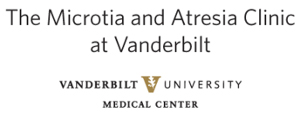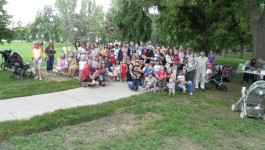A Letter From Dr. Brent, the Pioneer of the “Brent Technique” Rib Graft surgical technique…
Burt Brent M.D.
A Medical Corporation
Reconstructive Plastic Surgery
October 11, 2011
Dear Ms. Tumblin,
I have just returned to California after an extended stay in the Midwest and read your kind thank you note regarding our meeting in Denver. It was a pleasure to see you there along with Dr. Brad Kesser. It was nice to get acquainted with you and see your little daughter, Alyssa, along with her engaging older sister, Hailey. I was pleased to be able to spend sufficient time with you during the busy meeting of the American Society of Plastic Surgeons so that you and I had a good chance to visit and consult.
I have dedicated my professional life to caring for children with congenital differences, and am impressed not only with your devoted care for your daughter, but with your sincere and dedicated commitment to help other children with microtia-atresia and their families.
Your wonderful attitude that a child with microtia-atresia can grow up to be anything that she or he wishes to accomplish is spot on. I have taken care of children who have become professional singers, one who even sings opera; others who are scientists; teachers; engineers; an archeologist; and just about anything you can imagine. Having practiced for more than 30 years, I have reaped the reward of seeing a number of my little six-year-old patients grow up to become physicians. There are several who have even been inspired enough by the care delivered to them that they have become practicing plastic surgeons themselves! When I am asked how many children I have, my answer is “nearly 2,000!”
Your daughter, Ally, has a very typical grade 3 microtia, a condition I have treated hundreds of times. I have always thought of little microtia nubbins as flower-buds that have not yet bloomed and look upon my own work as helping these little buds to flower into full-sized ears made of the child’s very own tissues. I even use the bottom portion of that little “flower bud” to make the earlobe.
I have constructed ears for nearly 2,000 patients during my career, and have also seen many more on consultation whom I have not operated upon because they are either still too young or have not yet sought surgical treatment. As you can imagine, from the technical standpoint, repair of Ally’s ear would be very straight-forward for me. I like to use the patient’s own cartilage because it is alive and it grows with the child and therefore heals if there is a traumatic episode during sports and other activities throughout the person’s lifetime.
Of course, there are a number of things to consider in caring for a child with microtia and atresia. I think that it might be helpful if I summarize and elaborate upon some of the issues that I discussed with you during our visit. My thoughts are garnered from the insight I have gained over 35 years of surgically treating, consulting with, and/or otherwise caring for many hundreds of patients with microtia-atresia. It is amazing how we keep in touch throughout the years.
One of the main issues is timing, both for atresia repair and for construction of the outer ear. I will address these issues separately.
From the standpoint of the outer ear, I have yet to meet a child who is very concerned about their ears before age six; therefore, I wait until that age—more for emotional rather than technical considerations. As part of Piaget’s developmental theory, a child usually is not particularly concerned about her/his ear before then. Therefore, postoperative care can be a problem and I have found that the child might even be angry at her/his parents and me for subjecting them to surgery (and causing pain) before they understand the need for it. Regarding postoperative care, I personally feel that it’s enough to manage a child at age six; and that subjecting a 3, 4, or 5-year-old to this type of elective surgery would be unnecessarily trying for the child and everyone else involved in her/his care.
From the technical standpoint for repairing the outer ear, there are three different stances on the matter of age. I wait until age six, although this is more for emotional reasons that the technical standpoint—as I mentioned above. Dr. Nagata and my superb colleague, Francoise Firmin, wait until about age 10 because their styles of framework fabrication require far more rib cartilage than I use for my framework. Medpor surgeons are willing to begin earlier—as early as age 3 or 4, even though it would be difficult to know the true size to make an ear at that age. Remember that a child’s ear is not full grown by age six, and that rib cartilage ear frameworks are alive and grow with the child; Medpor is synthetic material and obviously cannot grow.
Disadvantages that I have heard cited by surgeons who promote the use synthetic Medpor frameworks are that the rib cartilage method is painful and requires days of hospitalization. This misconception needs to be clarified:
For the past 6-7 years I’ve done all of these surgeries at an outpatient Surgery Center where the family can stay with the child and only a 23-hour stay is required for the first stage rib cartilage operation. The morning after the rib cartilage operation, the children leave the facility with a bottle of Tylenol and codeine syrup, which they require only on an as-needed basis for just a few days. There is little, if any postoperative discomfort with the subsequent surgical stages, which are all done on an outpatient basis. Children heal and get over the surgery surprisingly quickly—the biggest problem is keeping these rambunctious little kids quiet and still during the postoperative period!
On the issue of age for atresia repair, although I am not an otologist, I have formulated a practical and pragmatic view which is based both on my intimate knowledge about wound healing and what I have learned from working with several very experienced otologists on hundreds and hundreds of children during the years.
I have reservations about atresia surgery being done on a very young child. Young children heal so well (something that is usually advantageous) that they can “over-heal” when it comes to atresia surgery—and they can actually re-grow the bone that had been drilled out during surgery and subsequently refill the surgically-created canal with new bone. This has been well documented by the olologic surgeon, Dr. S.O. Chang in an article about “Prevention of Postoperative Meatal Stenosis . . .” The Journal of Otology and Neurotology (23: 35-28, 2002). In this article which spans a 15-year period, he operated on 151 atresia ears over a 12-year period and demonstrated that stenosis (closing down of the canal by bony re-growth) was more common the younger the patient, particularly age 5 and under (well documented in Table 4 on p. 27 of his article).
Furthermore, from what I have learned from my otologic colleagues, long-term success of atresia surgery to maintain improved hearing strongly depends upon meticulously cleaning out the surgically-created canal 2-3 times a year under a microscope in the otologist’s office for the rest of the patient’s life. Expecting a 3-5 year old child to endure these procedures seems unrealistic to me and perhaps a further reason to defer atresia surgery until a later age.
Finally, the sequence of the canal and middle ear (atresia) is worth discussing. I personally think that it is advantageous to have the outer ear constructed before the atresia (canal) surgery because one has optimal unscarred skin to work with. If the atresia surgery is done first and the canal is created, the scarring that results from this procedure forces the surgeon to cover the framework with a skin-grafted scalp tissue flap that I have heard some surgeons casually refer to as a “membrane.” The scalp dissection necessary to utilize this “membrane” to cover an ear framework is invasive and extensive and employing this tissue flap robs the overlying scalp of the rich vascular tissue which is a major source of its circulation. I prefer to use the original virginal, unscarred skin around the microtia ear to cover the ear framework and reserve the “membrane flap” solely for emergency, salvage situations where traumatically scarred ears (from automobile accidents, dog bites, burns, and so forth) leave no other choice.
One final thought. In evaluating anybody’s work and results, it’s the long-term picture that one should look at and think about, not the “quick fix.” How things do and hold up for a year or two doesn’t matter. The question is how well results of atresia and/or outer ear surgery will hold up and remain problem-free into adulthood and for the rest of your daughter’s life. As you observed at the panel I moderated in Denver, a number of my patients have been followed for more than 20 years, and ears constructed from their own tissues retain their form and have withstood the test of time. All ears constructed with the patients own tissues by any competent plastic surgeon would be expected to last a lifetime. During the past 35+ years I have only seen two minor cartilage exposures, and both of these were easily repaired by a minor procedure. I think that you might find this a strong contrast from synthetic frameworks such as silicone and Medpor if you surveyed the thousands of plastic surgeons in practice in the United States and around the rest of the world.
In conclusion, I personally think that atresia surgery should not be done in really young children for the reasons cited above. From the standpoint of microtia repair, I find that ears constructed from the patient’s own rib cartilage grow with children, heal, retain their form indefinitely, and have withstood the test of time. The rough-and-tumble lifestyle of children will not destroy ears constructed from their own living tissue. Over the years, I have witnessed the survival of rib cartilage-formed ears from every type of trauma imaginable. The percentage of failed synthetic silicone ear frameworks has been well documented; the percentage of Medpor frameworks that will last long-term without troubles will only come to light over the ensuing decades.
I think that it might be prudent to wait until Ally is at least six before a decision is made to operate and make sure that she’s on board with whatever methods and timing all of you decide.
Thank you again for your profound interest and kind attention to this serious issue.
Sincerely and with kind regards,
Burt Brent, M.D.
2995 Woodside Rd., Suite 300, Woodside, CA 94062
Phone (650) 851-5300 Fax (650) 851-5302
Website: http://www.earsurgery.com Email: ears2you@earsurgery.com







Leave a Comment
You must be logged in to post a comment.